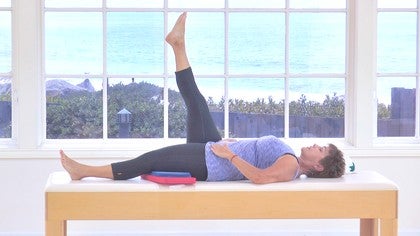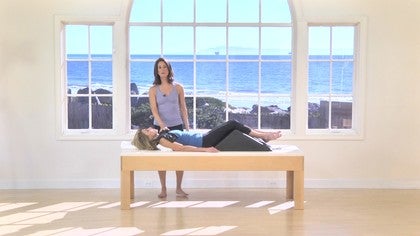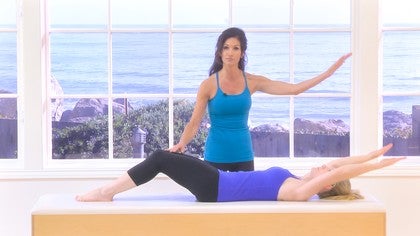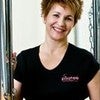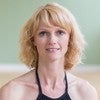Description
About This Video
Transcript
Read Full Transcript
This tutorial is called filled the empty space. In this section, what I'm going to show you are different things that you can use to fill an empty space that a client has during an exercise. Places that'll be important are the lumbar curve, the cervical curve behind the neck, and then right in the hip crease when you're on your tummy during any prone work. I'm going to start with an awareness of where the head is, so we'll start lying down, take my props with me, and the first thing I want you to be aware of is the position behind the neck. I'm going to choose this a little bit right here so that I can feel where my neck is, that little neutralness behind my neck so that if I indeed have to nod my chin a little bit as if I'm holding something underneath my chin, I'll feel the curve of my cervical spine kind of pressing down on this little shelf lining paper here. I'm not going to mash the heck out of it, nor am I going to let the shelf lighting paper stick my neck up. Some people need bigger sizes than others. If this role appeared to be too large to provide more tactile input into the neck, I may need to have a little smaller role there so I can feel where that is.
There. Again, I'm not smashing the roll down, nor am I allowing the roll to lift my head up. We can do the same thing in the low back. Sometimes in the low back. If a client has a flat back, I can put something right underneath the lumbar curve to facilitate a little bit of anterior curve, if you will, in the Lumbar area. I don't want to anterior your curl it so much that I create an anterior pelvic tilt, but I do want to create an awareness of where neutral is and sometimes in just filling that space behind the back, it allows me to give a tactile information to my spinal muscles as I work through the fundamentals either on the mat or on the reformer. There's another place where we often need to fill the empty space during the exercise called single leg circle, and that is with the down leg.
Oftentimes clients have a tight hip flexor, and when they go to do the exercise, single leg circle, sometimes they curl their pelvis and this thigh bulges up, changes the neck, changes everything. So I'm going to go back and reposition my head and neck level, my pelvis out to neutral, and then I'm going to give this left leg something to press on. And you'll notice here that I'm still in neutral and then I can circle my leg or lower and raise it or whatever I need to do while I'm giving this down leg feedback so that I'm filling this empty space behind the leg. If I were to have this and I had a tight hip flexor, sometimes by pressing my leg down or hearing the Q, press your leg, press your leg, I end up creating disturbance somewhere up the chain. So again, I can fill the empty space underneath the thigh to create a good single leg circle.
The next space that we need to fill is underneath the hip flexor. If during single leg circle you noticed that that pad that was underneath your thigh was very successful, then this, uh, prop may be successful for you as well. I'm going to put the blanket role, and again, I can use some shelf liner or anything else that allows me to prop my hip up. So it looks like this. I'm going to put this right at the level of where my hip creases, if you will, so that when I lie flat,
So I'm not tucking my buttocks. This is tucking my buttocks and kind of bulging my ribs backwards. But instead I'm resting down so that the hip flexor crease is actually being supported by this terrible. So what then this allows me to do is stretch my thighs long so that now I can give myself the feeling of what it feels like to activate my buttocks and my thigh. So again, the purpose of the towel roll is to fill the empty space that can be left by tight hip flexors. I'm going to show you what that looks like on some people.
My feet, by the way, are off the edge of the table because for some people, when their feet stay on the table, they get a little crampy. So again, I have filled the empty space right underneath my hips so that now I can get the action of hip extension freely. By the way, I can just lift my thighs up to that is the action of hip extension as well. Just simply like this lifting one leg would be an advancement and then lifting the other leg. Well, I think about, just really quickly, I mentioned something about how the, the feet can get cramped. Sometimes if you don't have the ability to lie off the edge of the table, you can just fill the empty space right underneath somebody's ankles just like this and that way. Um, it gives them something tactile to feel as their hands rest underneath their head and then their feet restaurant on the table. So then they could actually press down on the towel to tighten up their thighs as well.
So those are just some places where we can fill the empty space to help create connections throughout the body.
Begin Pilates: Modifications for Classes
Comments
You need to be a subscriber to post a comment.
Please Log In or Create an Account to start your free trial.
